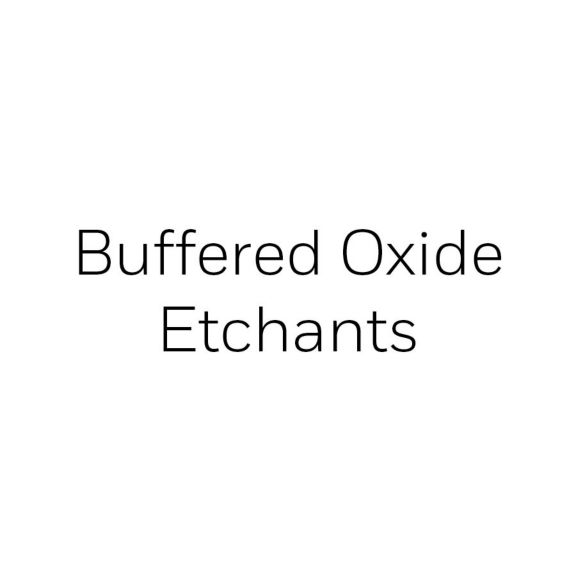Buffered Oxide Etchants
Buffered Oxide Etchant (17697)
13:2 VLSI Puranal
General Information
- Grade
- VLSI
- Synonyms
- Etchant
Physical Properties
- Boiling Point/Range
- No data available
- Color
- Colorless
- Density
- 1.120 g/cm3 (20 °C)
- Flashpoint
- Not applicable
- Melting Point/Range
- No data available
- Odor
- Stinging
- Partition Coefficient
- No data available
- pH
- Acidic
- Physical Form
- Liquid
- Solubility in Water
- Completely miscible
- Vapor Pressure
- similar to water hectopascal
Safety Information
- Chemical Stability
- Stable under normal conditions.
- Corrosivity
- Corrosive to metals
- Flammability
- Not applicable
- Ignition Temperature
- Not applicable
- Incompatible Materials
- Contact with strong acids liberates hydrogen fluoride, Corrosive in contact with metals, Glass and silicate-containing materials are attacked
- Oxidizing
- The substance or mixture is not classified as oxidizing.
- Self Ignition
- Not auto-flammable
- Thermal Decomposition
- No decomposition if used as directed.
International Transportation
- Chemical Class
- 8
- Harmonized System Code
- 38249996
- Packing Group
- II
- UN Number
- 3264
General Information
- Grade
- VLSI
- Synonyms
- Etchant
Physical Properties
- Boiling Point/Range
- No data available
- Color
- Colorless
- Density
- 1.120 g/cm3 (20 °C)
- Flashpoint
- Not applicable
- Melting Point/Range
- No data available
- Odor
- Stinging
- Partition Coefficient
- No data available
- pH
- Acidic
- Physical Form
- Liquid
- Solubility in Water
- Completely miscible
- Vapor Pressure
- similar to water hectopascal
Safety Information
- Chemical Stability
- Stable under normal conditions.
- Corrosivity
- Corrosive to metals
- Flammability
- Not applicable
- Ignition Temperature
- Not applicable
- Incompatible Materials
- Contact with strong acids liberates hydrogen fluoride, Corrosive in contact with metals, Glass and silicate-containing materials are attacked
- Oxidizing
- The substance or mixture is not classified as oxidizing.
- Self Ignition
- Not auto-flammable
- Thermal Decomposition
- No decomposition if used as directed.
International Transportation
- Chemical Class
- 8
- Harmonized System Code
- 38249996
- Packing Group
- II
- UN Number
- 3264
- Synonyms : Etchant
- Grade : VLSI
- pH : Acidic
- Color : Colorless
- Odor : Stinging
- Density : 1.120 g/cm3 (20 °C)
- Solubility in Water : Completely miscible
- Physical Form : Liquid
- Boiling Point/Range : No data available
- Flashpoint : Not applicable
- Partition Coefficient : No data available
- Vapor Pressure : similar to water hectopascal
- Melting Point/Range : No data available
- Corrosivity : Corrosive to metals
- Thermal Decomposition : No decomposition if used as directed.
- Oxidizing : The substance or mixture is not classified as oxidizing.
- Incompatible Materials : Contact with strong acids liberates hydrogen fluoride, Corrosive in contact with metals, Glass and silicate-containing materials are attacked
- Ignition Temperature : Not applicable
- Self Ignition : Not auto-flammable
- Chemical Stability : Stable under normal conditions.
- Flammability : Not applicable
- Packing Group : II
- Chemical Class : 8
- Harmonized System Code : 38249996
- UN Number : 3264




